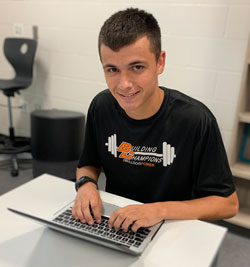Byron Center — Alec Steen spends a class period each day in Learning Strategies so he can receive a triple dose of what he is learning in his other classes.
“I like being in Strategies because it helps me focus more in a small group with other people and to be able to do my homework and study before a class,” said Alec, who is on track to graduate in May. He plans to attend Grand Rapids Community College and then perhaps transfer to Ferris State University and major in sports broadcasting. “I am able to pay attention more.”
Alec was working on personal finance homework in a suite of classrooms known as the Resource Room in Byron Center High School. He also gets help there in English, math and Spanish. Students in Learning Strategies have Individualized Education Plans, due to personal learning needs and goals. They need extra time in one or more areas of school, and Learning Strategies takes the place of one elective.
‘It’s a cool way for students to have some really targeted intervention based on exactly what they need on a given day and an efficient way for our staff to not be chasing their tails.’
— Principal Scott Joseph
The Resource Room is staffed by four teachers to provide instruction on the core classes — math, English, science and social studies. Over the past nine years, the program’s staff has grown from two teachers in English and math, then three to add science and now four to include social studies. They have four different hours of Learning Strategies to work with each grade level.
The teachers work with students in small groups of four or five using a “pre-teach and reteach model.” That means, first, students learn standards and lessons that are coming up in their classes, before their general education peers do. They learn them again in their subject-area classes, and If they still need support, they re-learn them one more time in Strategies.
“We’ve found it helps with confidence,” said Principal Scott Joseph, explaining how being exposed to content before their class helps students grasp it. A “reteach” session is yet another opportunity to master it. “The students are able to get an extra hour of whatever they need.”
Cool for Students, Helpful for Teachers
Science teacher Kaycee Ledeboer, English teacher Dani Stricklin, social studies teacher Audrey VanDokkumberg and math teacher Ashley Binger staff the program, evaluating as a team what each student needs and when. Students often split up their time between subjects.
“It’s a cool way for students to have some really targeted intervention based on exactly what they need on a given day and an efficient way for our staff to not be chasing their tails,” Joseph said.
Ledeboer said having each teacher focus on one content area creates a cohesive strategy in reaching every student. “It’s cool to (help students) who struggle, be in their corner, and help them make high school more feasible.”
“It helps our students stay on top of their work, and also helps them ask questions and feel comfortable to get the help that they need so they can be successful and also pass classes,” added Stricklin.

Effective in Many Areas
Byron Center High School is also implementing the model with general education students. Teachers and interventionists are working together to identify what standards students have not reached in courses and then using “pre-teach and reteach” during Flex Time — a half hour built into the school day twice a week when all students can receive extra instruction or catch up with coursework.
Teachers have seen progress with even some of the most resistant students, and nearly 100 percent of students who are enrolled in Strategies have graduated. Some have even graduated early.
“It has a lot to do with the smaller groups, multiple exposure to the same content and then just accommodations that are geared toward their specific disability,” Ledeboer said, explaining how a student with a math disability can approach the math in a physics lesson by learning math strategies that can be applied to that particular lesson.
For senior Donnie Clay, the support has helped him boost his reading skills. “I like it,” he said. “It benefits me a lot because I struggle with English. … My English grade has gone up quite a bit.”
“It helped me improve my grade. It helped me improve my reading accuracy,” added Donnie, who hopes to attend Grand Valley State University to pursue engineering. “My accuracy of retaining words is a lot better.”









